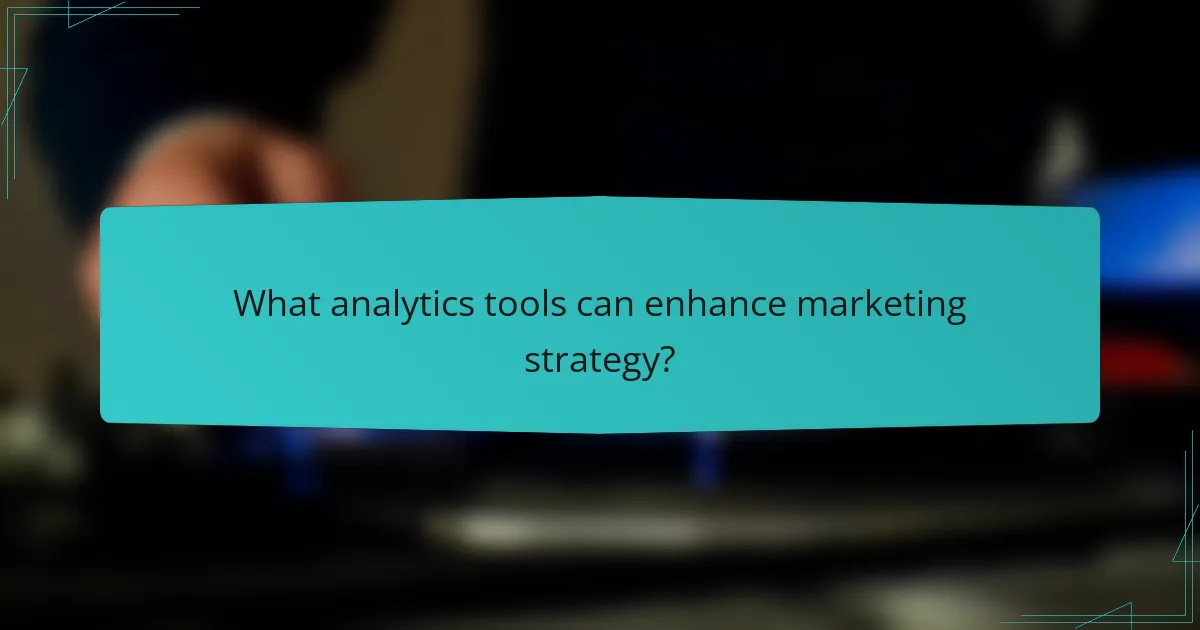In today’s digital landscape, effective marketing strategies are essential for engaging target audiences and driving product success. By utilizing a mix of channels such as content marketing, social media, and email campaigns, businesses can foster meaningful interactions while leveraging analytics to measure performance and optimize their efforts. Understanding key metrics like ROI and conversion rates is crucial for refining these strategies and enhancing overall effectiveness.

What are effective marketing strategies for digital products?
Effective marketing strategies for digital products focus on engaging the target audience through various channels while leveraging analytics to optimize performance. Key approaches include content marketing, email marketing, social media advertising, search engine optimization, and influencer partnerships.
Content marketing
Content marketing involves creating and distributing valuable content to attract and engage a specific audience. This strategy can include blog posts, videos, podcasts, and infographics that provide useful information related to your digital product.
To implement effective content marketing, identify your audience’s interests and pain points. Develop a content calendar to ensure consistency and consider using SEO techniques to enhance visibility. Aim for high-quality content that encourages sharing and interaction.
Email marketing
Email marketing is a direct way to reach potential customers by sending targeted messages to their inboxes. This strategy can include newsletters, promotional offers, and personalized content based on user behavior.
To maximize effectiveness, segment your email list to tailor messages to different audience groups. Use engaging subject lines and clear calls to action to improve open and click-through rates. Regularly analyze campaign performance to refine your approach.
Social media advertising
Social media advertising allows businesses to promote their digital products through targeted ads on platforms like Facebook, Instagram, and LinkedIn. This strategy can help reach a broader audience and drive traffic to your website or landing page.
Consider using A/B testing to determine which ad creatives and messages resonate best with your audience. Set clear objectives for your campaigns, such as increasing brand awareness or generating leads, and monitor key metrics to assess performance.
Search engine optimization
Search engine optimization (SEO) is the practice of enhancing your website’s visibility in search engine results. By optimizing content with relevant keywords and improving site structure, you can attract organic traffic to your digital products.
Focus on both on-page and off-page SEO techniques. On-page includes optimizing titles, meta descriptions, and content, while off-page involves building backlinks from reputable sites. Regularly update your content to keep it fresh and relevant.
Influencer partnerships
Influencer partnerships involve collaborating with individuals who have a significant following in your niche to promote your digital products. This strategy can enhance credibility and expand your reach to potential customers.
When selecting influencers, consider their audience demographics and engagement rates. Establish clear expectations for the partnership, including deliverables and compensation. Monitor the results to evaluate the effectiveness of the collaboration and adjust your strategy accordingly.

How can I measure the effectiveness of my marketing strategies?
Measuring the effectiveness of marketing strategies involves analyzing various metrics to determine how well your campaigns are performing. Key indicators such as KPIs, ROI, CAC, and conversion rates provide insights into the success and areas for improvement in your marketing efforts.
Key performance indicators (KPIs)
KPIs are quantifiable metrics that help assess the performance of your marketing strategies. Common KPIs include website traffic, engagement rates, and lead generation. Establishing clear KPIs tailored to your business goals allows for effective tracking and evaluation.
To set KPIs, consider your specific objectives, such as increasing brand awareness or boosting sales. Regularly review these indicators to adapt your strategies as needed, ensuring alignment with your overall marketing goals.
Return on investment (ROI)
ROI measures the profitability of your marketing investments by comparing the revenue generated to the costs incurred. A positive ROI indicates that your marketing strategies are effective, while a negative ROI suggests the need for reevaluation. Generally, a good ROI in marketing is often considered to be around 5:1, meaning for every dollar spent, five dollars are earned.
To calculate ROI, use the formula: (Net Profit / Cost of Investment) x 100. This calculation helps you understand which campaigns yield the best returns and guides future spending decisions.
Customer acquisition cost (CAC)
CAC is the total cost of acquiring a new customer, including marketing expenses and sales costs. Understanding CAC is crucial for evaluating the efficiency of your marketing strategies. A lower CAC indicates a more effective marketing approach, while a higher CAC may signal the need for optimization.
To calculate CAC, divide the total cost of sales and marketing by the number of new customers acquired in a specific period. Aim for a CAC that is significantly lower than the lifetime value of a customer (LTV) to ensure long-term profitability.
Conversion rates
Conversion rates measure the percentage of users who take a desired action, such as making a purchase or signing up for a newsletter. High conversion rates indicate effective marketing strategies, while low rates may highlight areas needing improvement. Typical conversion rates vary by industry but often range from 1% to 5% for e-commerce sites.
To improve conversion rates, focus on optimizing your landing pages, enhancing user experience, and employing clear calls-to-action. Regularly testing different approaches, such as A/B testing, can help identify what resonates best with your audience.

What channels are best for engaging digital product audiences?
To effectively engage digital product audiences, focus on channels that facilitate direct interaction and provide valuable content. Social media, email newsletters, webinars, and content sharing platforms are among the most effective channels for building relationships and driving engagement.
Social media platforms
Social media platforms like Facebook, Instagram, Twitter, and LinkedIn are essential for engaging digital product audiences. They allow brands to share updates, respond to customer inquiries, and create community discussions. Consider using targeted ads to reach specific demographics and increase visibility.
When using social media, prioritize consistency in posting and engage with your audience through comments and messages. Utilize analytics tools to track engagement metrics and adjust your strategy based on what resonates with your audience.
Email newsletters
Email newsletters remain a powerful tool for engaging audiences directly. They allow for personalized communication and can include product updates, promotions, and valuable content tailored to subscriber interests. Aim for a clear and compelling subject line to increase open rates.
To maximize effectiveness, segment your email list based on user behavior or preferences. This enables you to send targeted content that is more likely to drive engagement and conversions. Regularly analyze open and click-through rates to refine your approach.
Webinars and live events
Webinars and live events provide an interactive platform for engaging audiences, allowing for real-time questions and discussions. These formats can showcase product features, share industry insights, or offer training sessions. Promote these events through social media and email to maximize attendance.
Ensure that your webinars are well-structured and provide value to participants. Follow up with attendees afterward to gather feedback and maintain engagement. Consider offering exclusive content or discounts to encourage participation.
Content sharing platforms
Content sharing platforms such as YouTube, Medium, and SlideShare are effective for reaching wider audiences through valuable content. These platforms allow you to showcase expertise, share tutorials, and engage users with multimedia formats. Focus on creating high-quality, informative content that addresses audience needs.
Optimize your content for search engines to increase visibility and drive traffic. Encourage sharing and interaction by including calls to action and engaging visuals. Regularly monitor performance metrics to understand what types of content resonate best with your audience.

What analytics tools can enhance marketing strategy?
Analytics tools are essential for refining marketing strategies by providing insights into customer behavior, campaign performance, and overall engagement. Utilizing these tools can help marketers make data-driven decisions, optimize their efforts, and ultimately improve ROI.
Google Analytics
Google Analytics is a powerful web analytics service that tracks and reports website traffic. It allows marketers to understand user behavior, track conversions, and analyze the effectiveness of marketing campaigns through detailed reports.
To maximize its effectiveness, set up goals that align with your business objectives, such as lead generation or sales. Regularly review your traffic sources to identify which channels are driving the most conversions, and adjust your strategy accordingly.
HubSpot
HubSpot offers a comprehensive marketing analytics platform that integrates with its CRM tools. It provides insights into email marketing performance, social media engagement, and website analytics, all in one place.
Utilize HubSpot’s reporting tools to create custom dashboards that reflect your key performance indicators (KPIs). This can help you track the effectiveness of your inbound marketing efforts and refine your strategies based on real-time data.
SEMrush
SEMrush is primarily known for its SEO capabilities but also offers robust analytics features for tracking marketing performance. It provides insights into keyword rankings, competitor analysis, and backlink tracking.
Leverage SEMrush to conduct a competitive analysis and identify gaps in your strategy. Use its traffic analytics to understand where your competitors are gaining an advantage and adjust your marketing tactics to capture more market share.
Hootsuite
Hootsuite is a social media management tool that includes analytics for measuring social media performance. It allows marketers to track engagement metrics across various platforms, helping to gauge the effectiveness of social media campaigns.
Set up Hootsuite to generate reports on post performance, audience growth, and engagement rates. Regularly analyze these metrics to refine your content strategy and improve audience interaction on social media channels.

What criteria should I consider when selecting marketing channels?
When selecting marketing channels, consider factors such as your target audience, budget, and the specific goals of your campaign. These criteria will help you identify the most effective channels to reach and engage your customers.
Target audience demographics
Understanding your target audience demographics is crucial for selecting the right marketing channels. Consider factors like age, gender, location, and interests, as these will influence where and how you should market your products or services.
For example, younger audiences may be more active on social media platforms like Instagram or TikTok, while older demographics might prefer email newsletters or traditional media. Tailoring your channel selection to these preferences can enhance engagement and conversion rates.
Budget allocation
Your budget allocation plays a significant role in determining which marketing channels to pursue. Assess how much you can spend on each channel and prioritize those that offer the best return on investment (ROI).
For instance, if your budget is limited, you might focus on cost-effective digital channels like social media or email marketing rather than expensive traditional advertising. Establish a clear budget range for each channel to ensure you maximize your marketing efforts without overspending.



